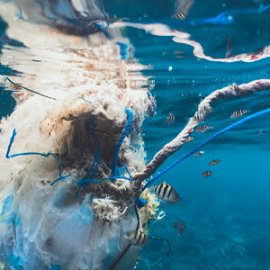A Plan for Plastic, part two
-
English
-
ListenPause
[intro music] Welcome to World Ocean Radio… I’m Peter Neill, Director of the World Ocean Observatory. In the last edition of World Ocean Radio, I introduced a report prepared by the Pew Foundation and SYSTEMIQ, a systems change company, that surveyed one of the ocean’s most pressing problems: the increasing and pervasive presence of plastic being disposed into our rivers and streams, and finally into the ocean in amounts that clog our estuaries, befoul our beaches, and invade and debilitate the natural ocean systems on which so much of our food and health depends. The accumulation, diminished into toxic chemicals and micro-beads, infuses the water column, marine species, and, penultimately, our bodies through our consumption of ocean-derived resources. The findings of the Pew/SYSTEMIQ Report were outlined in the last edition – suffice it to say they were very discouraging. But what was unique beyond the comprehensive research and depressing trends, was a list of specific recommendations for actions to redress the situation was offered – in effect a coherent Plan for Plastic. Here are some of the actions suggested: Understand the distinction and necessary strategies required to address upstream versus downstream conditions, each requiring different technologies and approaches. Insist that currently available technologies, management practices, and policy approaches be applied and adequately funded, including reduction, recycling, and plastic substitution; in effect, apply what we already know to what we already have. Demand limitation of plastic production at the source, through elimination, expansion of consumer re-use options, and new delivery models. Substitute plastic with paper and composable materials. Design products and packaging for recycling to expand share of economically recyclable plastic to 54 percent. Expand and support waste collection in middle- and low-income countries to 90% in urban areas, and to 50% in rural areas. Double mechanical recycling capacity globally to 86 million metric tons per year. Develop plastic-to-plastic conversion, to a global capacity of up to 13 million metric tons per year. As a transitional measure build facilities to dispose of 23 % of plastic that cannot be recycled economically... Reduce plastic waste exports by 90 % to countries with low collection and high leakage rates. Roll out known solutions for four microplastic sources—tires, textiles, personal care products, and production pellets—to reduce annual microplastic leakage to the ocean by 1.8 million metric tones per year by 2040. Require substantial shift in investment away from production and conversion of virgin plastic to the production of plastic substitutes, new delivery models, recycling facilities, and collection infrastructure. What we have here is a framework, but only as good as the funding and implementation to follow. How does that work? Will the Pew Foundation and SYSTEMIQ put their considerable assets and skills behind the plan? How will these initiatives be incentivized? How will the high-income countries respond to changes that may go against established interests? How will low-income countries afford to instigate these changes without substantial assistance? Will the UN agencies, the World Bank, and other international and national funding entities buy into the plan, take a piece, and make it real? There are many national and international groups committed to solve the plastic problem. What if, like a school of fish in the ocean, they all turned at once in the same direction, pooled their resources, and accepted individual integration as part of the whole? There is an excellent example of how it can work: over the past decade, the Pew Foundation has assumed a powerful lead in the campaign for marine protected areas, a plan that persuaded the UN, many governments and other environmental groups to join in a shared vision to protect ocean national resources by direct political action, regulatory power, and appropriate finance. It is one of the most successful collective actions for ocean conservation to date. And here we are again, with a new opportunity: to execute a transformational plan for plastic. After the World Ocean Summit in Lisbon [Portugal] in July, a group of eleven private philanthropies announced the “Protecting Our Planet Challenge,” a pledge US$5 billion in new support for ocean sustainability goals to be achieved by 2030. Those goals were lofty and aspirational. In the announcement press release, the world “plastic” was not mentioned. We will discuss these issues, and more, in future editions of World Ocean Radio. [outro music]
This week, part two of a two-part series laying out steps with examples that represent a coherent and provocative way forward toward a plastic-free future. In this episode we discuss the list of specific recommendations from the Pew Foundation / SYSTEMIQ Report, actions to redress the plastic pollution crisis--in effect a coherent Plan for Plastic.
About World Ocean Radio
5-minute weekly insights dive into ocean science, advocacy and education hosted by Peter Neill, lifelong ocean advocate and maritime expert. Episodes offer perspectives on global ocean issues and viable solutions, and celebrate exemplary projects. Available for syndicated use at no cost by college and community radio stations worldwide.
Image
Naja Bertolt Jensen on Unsplash
@naja_bertolt_jensen
Episode Resources
Visit: pewtrusts.org
- Login to post comments



